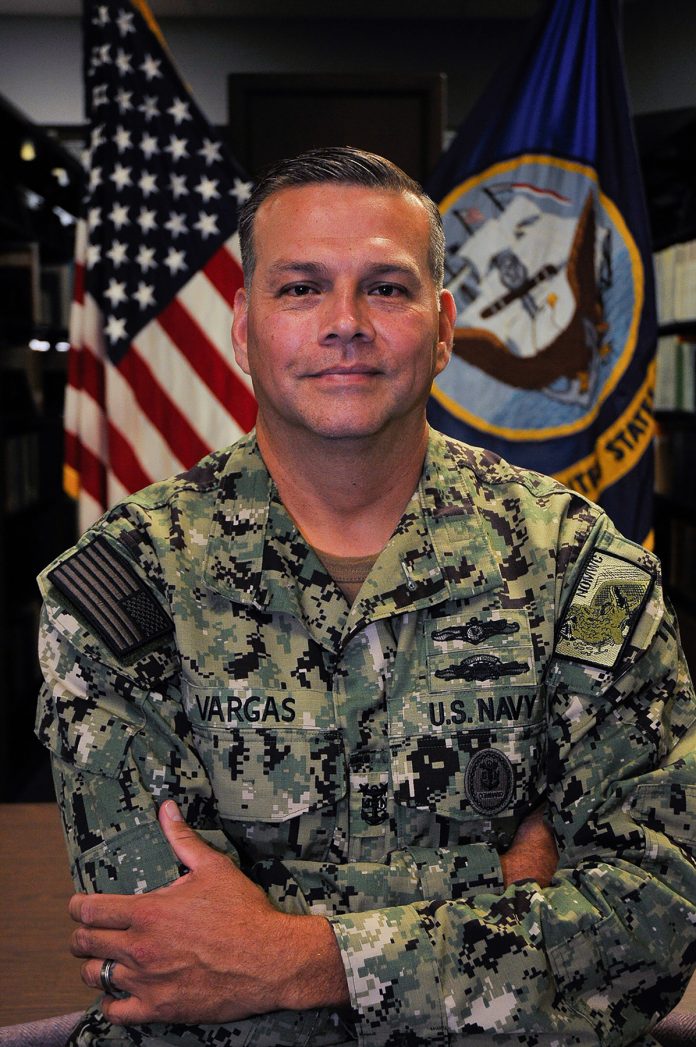By Megan Brown
Navy Office of Community Outreach
GULFPORT, MISS. Master Chief Petty Officer Edward Vargas, a native of Crane, is part of Naval Oceanography, serving to ensure the U.S. Navy maintains freedom from the ocean floor to the stars at Naval Oceanography Mine Warfare Center.
Sailors and civilians working throughout Naval Oceanography collect, measure, and analyze the elements of the physical environment (land, sea, air, space). They synthesize a vast array of oceanographic and meteorological data to produce forecasts and warnings in support of safety of flight and navigation.
Vargas, a 1997 Crane High School graduate and one of 10 master chief aerographer’s mates in the Navy, currently serves at Naval Oceanography Mine Warfare Center, headquartered at the Stennis Space Center in Mississippi.
“I want to thank my whole family for their support,” said Vargas. “I am one of 15 siblings. Every time I go, they are my greatest supporters. If I ever need anything they are always there. We have a military family and my real family.”
“Naval Oceanography operates simultaneously at the strategic, operational and tactical levels of warfare in every theater around the globe,” said Rear Adm. Ron Piret, commanding officer, Naval Meteorology and Oceanography Command. “We pride ourselves in our ability to characterize the battle space and then predict changes in the environment over time. Every ship that sails, every aircraft that takes flight, every submarine that dives beneath the surface of the ocean has to go to sea with the information that Naval Oceanography provides.”
According to Vargas, the values required to succeed in the Navy are similar to those found in Crane.
“I come from a small town,” said Vargas. “We have 2,000-3,000 people. Everyone knew everyone, and we all depended on each other. I learned from being in band and on the football team the value of hard work, to treat everyone with respect, to help others be successful and finish something if you start it.”
Naval Oceanography personnel demonstrate expertise in Hydrography, Geospatial Information and Services (GIS), datum issues, and Tactical Decision Aids (TDA). They combine knowledge of the operating environment with a thorough understanding of warfighting capabilities to assess and predict environmental impacts to friendly and enemy platforms, sensors and weapon systems.
Serving in the Navy means Vargas is part of a team that is taking on new importance in America’s focus on strengthening alliances, modernizing capabilities, increasing capacities and maintaining military readiness in support of the National Defense Strategy.
“The Navy is the tool that allows us to protect U.S. interests here and abroad,” said Vargas. “The Navy also keeps shipping lanes open and maintains peace. It is a big deterrent when you have countries that are trying to stir up trouble abroad.”
With more than 90 percent of all trade traveling by sea, and 95 percent of the world’s international phone and internet traffic carried through fiber optic cables lying on the ocean floor, Navy officials continue to emphasize the importance of accelerating America’s advantage at sea.
“Maintaining the world’s best Navy is an investment in the security and prosperity of the United States, as well as the stability of our world,” said Adm. Mike Gilday, Chief of Naval Operations. “The U.S. Navy — forward deployed and integrated with all elements of national power — deters conflict, strengthens our alliances and partnerships, and guarantees free and open access to the world’s oceans. As the United States responds to the security environment through integrated deterrence, our Navy must continue to deploy forward and campaign with a ready, capable, combat-credible fleet.”
Vargas and the sailors and the civilians they serve with have many opportunities to achieve accomplishments during their military service.
“I am most proud of joining the chief ranks,” said Vargas. “Since day one, I always leaned on my chief to help me out. When I was selected to be chief, I was thankful because now I could give that back to my sailors. I was just selected to be a master chief. It is a big privilege and honor because I am one of 10 in our community.”
As Vargas and other sailors and civilians continue to train and perform missions, they take pride in keeping fellow sailors and civilians safe and serving their country in the United States Navy.
“Serving in the Navy has been an adventure,” added Vargas. “Coming from a small West Texas town, I never thought I would be in different locations around the world operating equipment. I grew up in the Navy. You can’t experience this anywhere else. I have been serving for 24 years, and I’ll stay in the Navy as long as they have me.”
Naval Oceanography directs and oversees more than 2,500 globally distributed military and civilian personnel who collect, process and exploit environmental information to assist Fleet and Joint Commanders in all warfare areas to make better decisions, based on assured environmental information, faster than the adversary.




